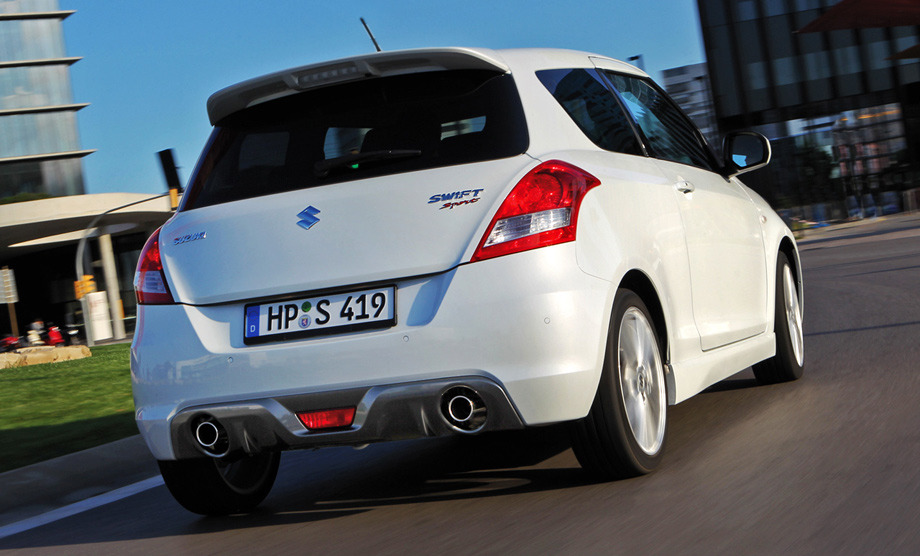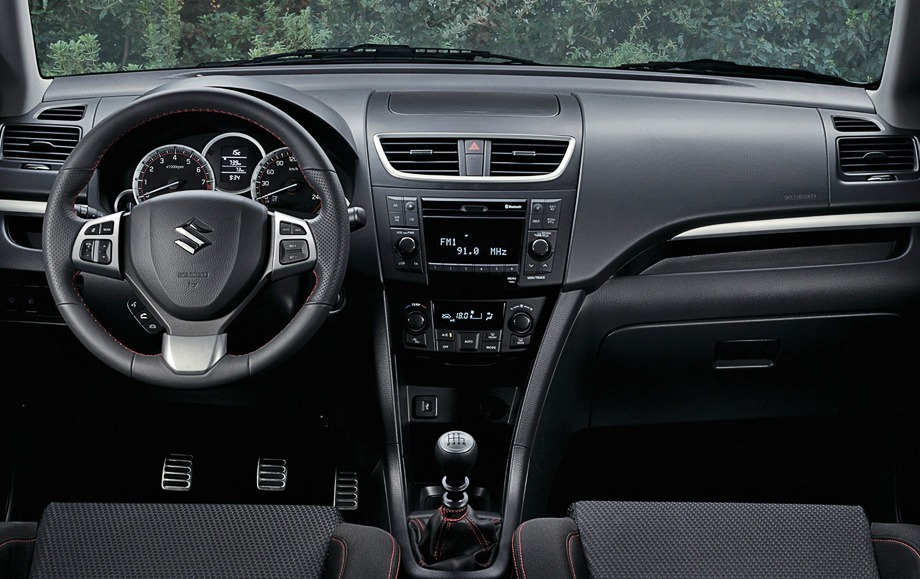Suzuki Swift Sport

Specifications Suzuki Swift Sport FF/6MT:
Body: CBA-ZC32S
Dimensions of the body length * width * height, mm: 3890 * 1695 * 1510
Wheelbase, mm: 2430
Wheel track, front / rear, mm: 1470/1475
Minimum ground clearance mm: 130
Dimensions of the cabin, length * width * height, mm: 1905 * 1385 * 1225
The mass of the car in unfilled state: 1050 kg
Mass of vehicle in running order: 1325 kg
Number of seats: 5
Turning radius: 5,2 m
Engine: M16A, 1586 cu. cm, 4-cylinder, direct injection and water-cooled DOHC 16 valve
Maximum Power: 136 hp (100 kW) / 6900 rev / min
Maximum torque: 160Nm (16.3 kgm) / 4400 rev / min
Bore * Stroke, mm: 78.0 * 83.0
Compression ratio: 11.0
Transmission: 6MT
Fuel tank: 42 liters
Flow rate: 15 ~ 16 km / l (about 6.5 l/100 km)
Tyre size: 195/45R17
Hatchback Swift Sport looks at all 200 power! Expressive bumpers, massive door sill covers, large wheels and a seat in relief ... Spoiler above the rear door visor reminiscent of hooligan expanded cap. You'd never guess that the bifurcated exhaust pipes belong to the engine, which develops a modest 136 hp Expendables Japanese claim that the main thing in this project - the balance. The balance between the recoil engine, its efficiency and overall cost to develop the car. At the same time on the actual costs, they prefer to remain silent, leaving as a counterweight to the appropriate side of the balance passport consumption on the combined cycle - 6.4 l/100 km.
What lies on the other side, too, is not clear. At least the buyer. The car is already on sale, but on the official site of Suzuki in Germany does not disclose such data to 100 km / h Shy? Not at all: in press materials that are inaccessible to the average consumer, said that the first hundred trehdverka gaining in 8.7 s. No wonder: we know that the power supply capacity increased from 114 hp per ton, up 122. As we see, even gain of 15 kg has not made the new Swift Sport (mass 1115 kg) slower 125-strong precursor for which the stated time to disperse hundreds of 8.9 s. It is clear that the Swift Sport is not a competitor to, say, my 197-strong Clio RS, but, according to subjective feelings of ten seconds, Suzuki travels easily.

For the Euro-5 engine with the "quartet" 1.6 quick responses to the fuel supply. Sound? Assertive, crisp hum, transforming at high speeds in a ringing metallic cry. According to his passport a top speed of 195 km / h
Swift Sport previous generation and the atmospheric "quartet" 06.01 new to me. The upgraded version of the motor with phase shifters at the inlet and outlet on the whole much. The main thing - to get rid of the influence of mental Sport makeweight in the title of the car. The nature devoid of any strain was sporting, he lacks development. The engine pulls smoothly and strongly from 2000 rev / min until the cut-off, gently hanging on the limiter. But even in the immediate vicinity of the seven thousandth mark explosion of temperament is not observed.

In spite of the metallic insert, gloomy interiors, materials cheap. But for ease of use controls do not reproach. Steering wheel with a rim diameter of the optimal fine is in their hands, the instrument panel is informative.
Hard seat upholstery with tenacious and strong lateral support rollers - a great benefit. Adjustments to the steering column and driver's seat is enough to sit in sports is low.
Trehdverka mass of 1115 kg equipped with a new six-step "mechanics" (earlier in Swift was "pyatistupka"). The moves are conveniently located lever and the selectivity of the drive - normal, at the level of the highest quality of opponents without any "sports" in the title. The mechanism, however, gives the impression calibrated to the conscience: the first and second stages used the refined synchronizers, reduced friction loss for a more flexible and precise switching. A number of not very short, hundreds of car speedometer dials the second. The first three gears of the dynamics enough even on the track, not to mention the city. In the future, overcoming the resistance of the air hatchback with mild shortness of breath.
Pacific Swift Sport car is not called. At low and medium speeds dopekaet noise from the wheel arches, the high - and even the wind whistling in the area of the windshield and side mirrors.
However, this does not prevent him to develop almost 200 km / h on the speedometer on the longest straight to the landfill. After 150 km / h the car literally sticks to the road is filled with the weight of the wheel that allows you to accurately keep Swift within the band. However, in the first more or less sharp turn in response to the smooth and dynamic movement of the wheel Suzuki crouches noticeably to one side. Plump cushion seat bites into the ribs. Only in the long running arc roll increases sufficiently smoothly to an unexpected sensitivity to the lateral forces of the suspension did not attract attention. Nevertheless, the Japanese argue that the current Swift heels up to 15% more restrained than before.

As a measure of acute and informative steering - a strength of Swift. He dives into the turns without balking at the input, allowing you to feel the steered wheels almost fingertips. If the car does not provoke a sharp discharge of gas, it will amuse the driver's commendable tenacity in turns.
In a soft suspension has its advantages. How noble are smoothed grassy hills at the sides of the track! In this case the "sport" steering information only Swift, who immediately announces the start of demolition at the brute speed. And what a visual reaction to the redistribution of weight! When the system is off rear axle stabilization playfully slips at each unloading at the entrance to a turn. Short lunge driving enough to stabilize the car. As if you're hands on the roof rearranges toy car on the road. And no duplicity: Swift Sport is unambiguous and predictable in the reactions. If only his more powerful brakes. A single-mechanism overheated a couple of laps, the pedal gets a stake ...

On the test car fitted as an optional xenon headlights with light. In the standard halogen headlights are. The new model was longer by 125 mm compared to the previous one. However, the use of body structure, among other things, vysokorastyazhimogo steel sheet to facilitate the overall vehicle weight by 10 kg. The size of the wheels on this model installed 195/45R17. On the test car is tires from Bridgestone RE050A. M16A Engine 1.6-liter direct injection produces 136 hp and 16.3 kgm. Catalogue fuel consumption 14.8 km / l.
Yet here we must pay attention to the next thing. The very method of measurement, which involves an engine capacity and the noise level is set to capitalize it out of automatic transmissions, and even a pair of main gear ratio gear set to low. What will happen in the real world? Riding in full accordance with the mode of measurement is not always possible, and maintain a steady speed highway is not necessary. In a rapidly changing traffic situation, is more efficient to manage a manual transmission directly by the driver.
Be that as it may, the automatic switching speed behaves expected and predictable, and there are many examples of even the famous German car manufacturers, when the inclusion of low transmission, as if the driver is well and ably managed the handle or toggle switches to higher gear at the same time makes a wait. Besides, if we talk about managing the clutch, then there are moments when you need to smoothly connect the clutch to the transmission or clutch to transfer directly to an instant. Automatically change the category of softness and hardness of bonding is impossible.
Automatic transmissions, which are installed in modern cars, customized, first of all, the smooth soft switching speed, and make upshifts at reasonable necessity. By lowering the transmission, throttle works well in accordance with the turns of the motor, but with an increase in the transfer must wait until the engine speed will fall by themselves.
To this was done, the connection must be so dense that the hair does not climbed, and a keen sense of the actual gear is available only with manual transmission. At a time when there is a connection with the clutch, there is a slight push. Then, to the extent of the shift knob, tremors are felt weaker and weaker. In the end, for the most ardent lovers of mechanical transmission, complete lack of shock when you switch it would probably not interesting ...
As for the clutch, its wear resistance is very improved. The use of materials made in Japan and by the standards of Japanese manufacturers, prolongs the life of unit: This item may last for a car about 250 000 km, which corresponds to international standards. Compared with AT, the work which is designed for about 100,000 miles, manual transmission have enough time. At the same time change the consumables or defective parts is relatively easy. Repair of automatic transmission - it is very difficult and troublesome, so it is usually changed entirely.
